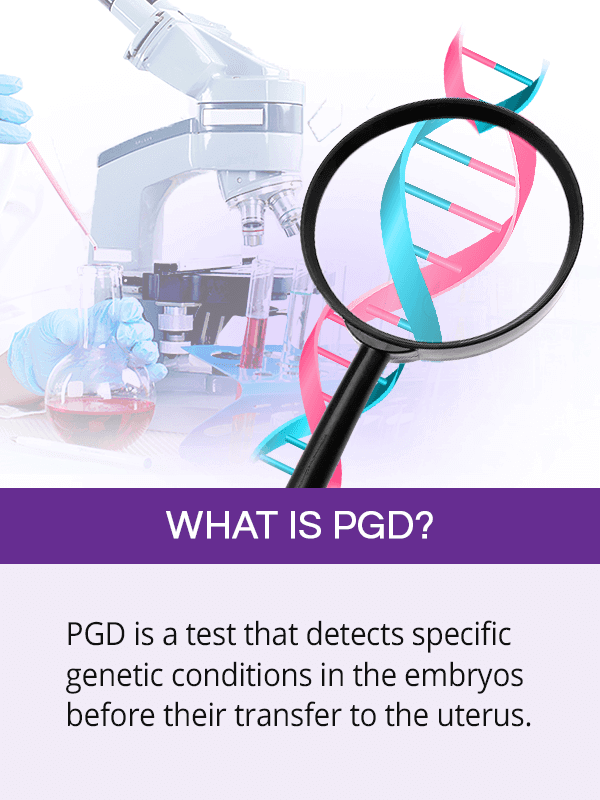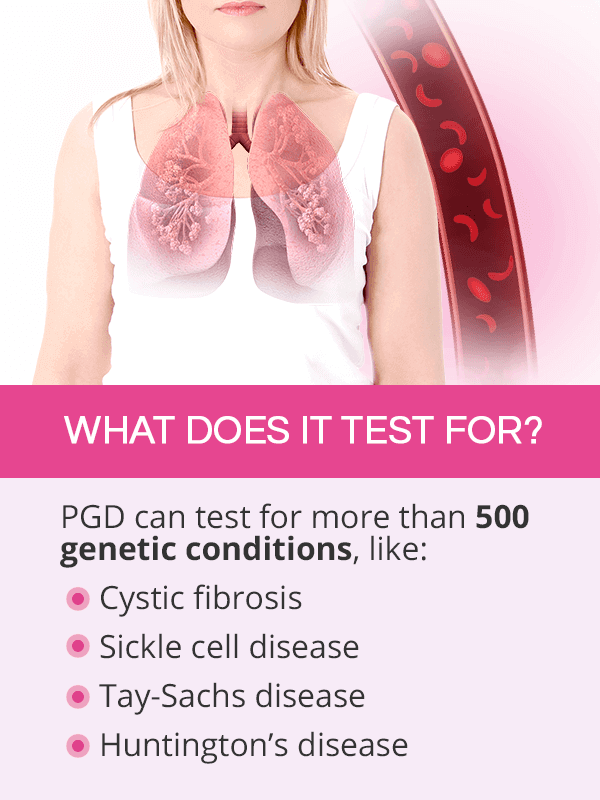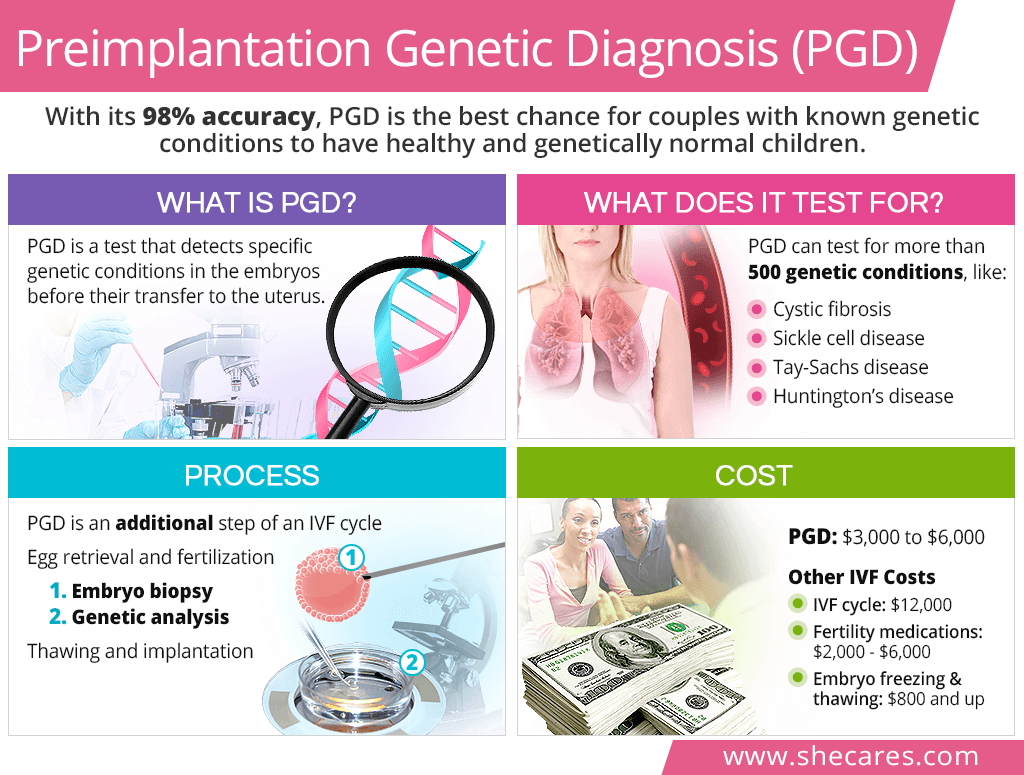What is PGD?

Preimplantation genetic diagnosis is a procedure used to detect specific genetic conditions in the embryos before their transfer to the uterus. As such, a couple can select embryos free of genetic mutations for implantation.
PGD should not be confused with PGS, preimplantation genetic screening, which is a more general scan of the embryo for an abnormal number of chromosomes. PGD, on the other hand, tests for a specific genetic condition.
PGD is an additional step during in vitro fertilization (IVF), which can be performed at a couple's request if one or both partners have a known genetic condition or are carriers thereof. Women with recurrent miscarriages, those undergoing IVF at an advanced age, or those who have had several failed infertility treatments might also benefit from undergoing PGD.
What Does PGD Test For?

Preimplantation genetic diagnosis is capable of testing for more than 500 genetic conditions, most common ones including the following:
- Cystic fibrosis
- Sickle cell disease
- Tay-Sachs disease
- Thalassemia
- Huntington's disease
- Spinal muscular atrophy (SMA)
- Hemophilia
- Fragile X
PGD Process

PGD is performed in the middle of the IVF process, right after eggs are retrieved from the ovaries and fertilized in vitro and before they are transferred back to the uterus. There are two steps to the PGD process itself:
Embryo biopsy. It consists of removing a few cells from the blastocyst, which is the name of the growing embryo, on the third or fifth day of its development.
Genetic analysis. Genetic testing typically takes up to 10 days, during which time the blastocyst is frozen to pause its development. Once results are available, the embryos will be thawed to then be transferred to the uterus.
An additional step during the PGD process might be gender selection, which allows identification of female or male embryos and implanting those of one gender according to personal preference.
PGD Testing Risks & Concerns
Although PGD is a safe and greatly effective reproductive procedure, there are some important measures to take into consideration before making the decision.
Ethical Dilemmas
The main ethical dilemma around preimplantation genetic diagnosis is defining when human life begins. In biological terms, life begins at conception, the union of the sperm with the egg. As such, the main concern is the fate of the embryos with identified genetic conditions that couples do not wish to use for IVF.
Damage to the Embryos
Although rare, certain biopsy procedures as well as the freezing and thawing processes might possibly cause damage to the embryos and render then nonviable. As such, it is important to choose PGD clinics with a good reputation and highly qualified specialists.
Accuracy
Although PGD success rates are said to be as high as 98%, it is possible for the results to be inaccurate. Consequently, pregnant women should not treat PGD as a replacement for prenatal testing, like amniocentesis and chorionic villus sampling (CVS) that can further rule out genetic anomalies.
PGD Cost

Although effective, PGD testing is known to be expensive as its costs can range from $3,000 to $6,000, though the price at some fertility clinics might be even higher.
PGD cost does not include other costs of IVF. Though some clinics offer PGD-IVF packages to help couples manage the rising costs of undergoing fertility treatments, a general breakdown of individual costs of a single IVF cycle are as follows:
IVF cycle (retrieval and transfer): about $12,000
Fertility medications: $2,000 - $6,000
Embryo freezing & thawing: $800 and up
Key Takeaways
This advanced procedure, performed as an additional step during IVF, consists of removing several cells from the embryo and testing them for the genetic abnormality. As such, preimplantation genetic diagnosis allows parents to decide which embryos they want to transfer to the uterus for implantation and whether proceeding with IVF is a viable option for them. Its 98% effectiveness, however, does not come at a cheap price. On top of the expenses of undergoing IVF, PGD costs add an additional $3,000 to $6,000. Most specialists agree that the benefits of PGD heavily outweigh the costs as for couples with known hereditary conditions, it is the best and sometimes the only chance for having healthy children.
Sources
- AMA Journal of Ethics. (n.d.). Preimplantation Genetic Diagnosis. Retrieved April 1, 2019 from https://journalofethics.ama-assn.org/article/preimplantation-genetic-diagnosis/2001-08
- American Pregnancy Association. (2019). Preimplantation Genetic Diagnosis: PGD. Retrieved April 1, 2019 from https://americanpregnancy.org/infertility/preimplantation-genetic-diagnosis/
- Clinical Chemistry. (2013). The Ethical Implications of Preimplantation Genetic Diagnosis. Retrieved April 1, 2019 from http://clinchem.aaccjnls.org/content/60/1/25
- BioMed Research International. (2016). The Impact of Biopsy on Human Embryo Developmental Potential during Preimplantation Genetic Diagnosis. Retrieved April 1, 2019 from https://www.ncbi.nlm.nih.gov/pmc/articles/PMC4749789/
- Human Reproduction. (2010). Children born after preimplantation genetic diagnosis show no increase in congenital anomalies. Retrieved April 1, 2019 from https://academic.oup.com/humrep/article/25/1/6/699708
- Human Fertilisation & Embryology Authority. (n.d.). PGD Conditions. Retrieved April 1, 2019 from https://www.hfea.gov.uk/pgd-conditions/
